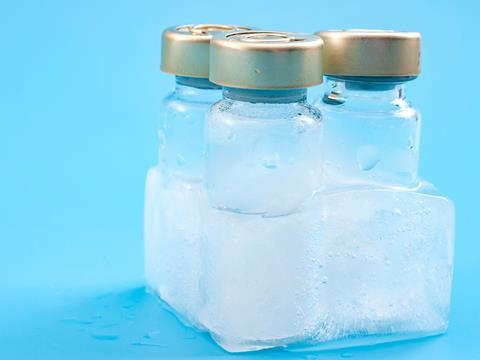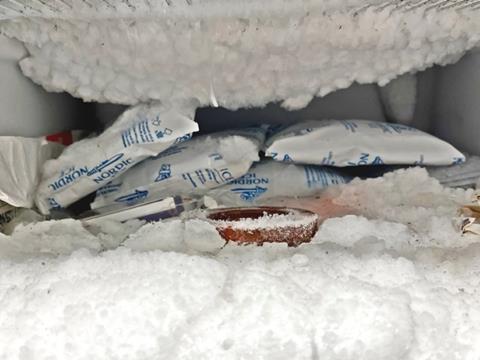
Researchers at the University of Illinois Chicago have developed a range of coatings for industrial surfaces that use a specialised chemical composition to delay the formation of ice. This can help to protect contents such as vaccines freezing inside of vials during ultra-cold chain transport, in turn maintaining their efficacy.
Mr Rukmava Chatterjee, one of the researchers involved in creating the coatings, discusses how they can be used to complement multiple packaging applications across the supply chain while offering a lower environmental footprint than typical anti-freeze alternatives.

The impetus for anti-ice solutions
“Supply chain management of cold-storage units is critical for various industries ranging from healthcare to food,” Chatterjee explains. “Be it the delicate cut of Wagyu beef or critical COVID-19 vaccine, most items have a limited shelf life, necessitate appropriate packaging, and storage at tightly controlled temperatures from the time they are manufactured until they reach the end user; a critical task accomplished by a worldwide network of transportation and storage facilities.”
However, the complexities of global supply chains and the intensive requirements of some forms of transport can give rise to what Chatterjee identifies as “inherent problems of the system” involving temperature fluctuations of the products themselves. The freezing of products inside packaging can interfere with their integrity, while the accumulation of ice on the internal or external surfaces of containers and vehicles can inhibit their function and safety.
While some solutions, such as superhydrophobic surfaces and lubricants, have been developed, the research paper written by Chatterjee and his research partners, Hassan Bararnia and Sushant Anand, notes significant drawbacks to these technologies, such as their inability to cope with high humidity and how quickly they can be removed by shear forces, rendering them temporary. According to Chatterjee, “the financial market for anti-icing and icephobic materials amounts to 20 billion USD annually. Unfortunately, most of the passive ice-shedding techniques typically employed, either bear expensive fabrication costs or suffer from poor long-term durability.”
This apparently means that “energetically expensive” active solutions with “a negative environmental footprint”, such as chemical de-icing and mechanical scraping, continue to be favoured by the industry. Therefore, while “technologies that can delay ice/frost formation on surfaces or facilitate its passive removal play a pivotal role in industrial applications operating in frigid climates”, Chatterjee and his colleagues identified a gap in the market for durable, lasting solutions with minimal environmental impacts.

Incorporating sustainability
The UIC research team have “formulated an extensive library of more than eighty compositions with superior freeze-protection properties”. The main component of the coatings is dimethyl sulfoxide (DMSO), which Chatterjee identifies as “a bio-friendly cryoprotectant that can be securely locked in a polymeric matrix, which grants it enhanced resistance against dissolution and shear-driven removal”. Chatterjee adds that DMSO is a “well-known industrial solvent” that is derived from wood.
For the researchers’ anti-freezing gels, a variation that Chatterjee claims are “amongst our best-performing coatings” includes only one component other than DMSO: gelatine. “Gelatine as you know is used for making a variety of desserts [and] puddings,” Chatterjee notes. “Hence, all the coating materials are bio-friendly in nature, and not expected to have any sort of detrimental effect on the environment.”
According to Chatterjee, the coatings “function by leveraging certain thermoresponsive properties, allowing them to generate a slippery lubricating layer on their surface which acts as a protective barrier against contaminants ranging from miniscule bacteria to macroscale frost”. This means the coatings are “multifunctional by design”.
Compared to untreated industrial metal surfaces, such as aluminium, the researchers’ coatings can reportedly delay the formation of ice for around 87 times longer and make ice shedding approximately 665 times easier. Chatterjee says this sets the coatings apart as “a complete game-changer when compared to most of the commercial coatings available in today’s market”.
Complementary applications
The multifunctional nature of the coatings developed by the University of Illinois Chicago team makes them suitable for a range of applications, which can, in turn, support packaging in ensuring the safety of products throughout the supply chain.
For vaccines, temperature fluctuations during storage and shipment can compromise their “nutritional value or immunological potency, eventually resulting in financial losses in billions of dollars” in the case that they are deemed unusable and destroyed, Chatterjee explains. “A widespread problem which occurs during storage in such cryogenic conditions is the accidental freezing of the inner contents of drugs/vaccines themselves in the cold chain. For example, the World Health Organization (WHO) guidelines dictate that adjuvant vaccines (e.g., hepatitis B vaccine) should not be subjected to freezing temperatures.”
Similarly, the build-up of ice on the internal surface of secondary packaging like cold chain storage boxes can make it difficult to detach or retrieve products from inside. The surface of the packaging could also be damaged in the process of separating it from the accumulation of ice, again compromising the product inside. In the case of frozen food packaged in flexible plastic packaging, for example, a tear in the surface acquired during transport could mean it fails quality control and does not make it to the shelf, resulting in both a loss of money and food waste.
In addition, some of the coatings also have anti-bacterial properties. Chatterjee offers the example of a coating that can simultaneously “prevent a smartwatch’s battery from dying in the frigid winter” and “preclude any bacterial contamination”. As part of their research, the UIC team demonstrated that there was no build-up of e. coli on the coated smartwatch surface compared to an uncoated control over a seven-day period. This feature could also lend itself to the packaging of food, with antimicrobial food coatings being a rapidly growing research and development segment worldwide. “Additionally, it can also be used in healthcare/pharmaceutical industries looking for anti-bacterial coatings,” Chatterjee notes.
The coatings also work on a larger scale to protect vehicles like planes or energy infrastructure such as wind turbines, both of which are essential to packaging as an energy-intensive industry with complex and comprehensive supply chains. “The versatile nature of their performance attributes causes them to be applicable to a wide range of industries, especially the ones requiring state-of-the art winterization and freeze-protection,” Chatterjee tells us. “So, our coatings can in general find usage in industries operating during the winter season: aerospace, wind turbines, off-shore oil rigs, marine vessels, automotives, power transmission lines, HVAC, vaccine cold chains, building infrastructure, etc.”
The use of the UIC researchers’ coatings can therefore enhance the protection of sensitive products, especially for the pharmaceutical and food sectors, as they move through the supply chain, enhancing the function of packaging or preventing it from being damaged.
What’s next?
The coatings are gaining traction in the industry, with the solution featured on the front cover of the Advanced Materials academic journal earlier this month. “Due to the versatile commercial applications, we have filed for a worldwide patent application titled ‘Compositions and Methods for Inhibiting Ice Formation on Surfaces’ with UIC’s Office of Technology Management,” Chatterjee adds.
Overall, the next steps for the coatings include “making even more durable gels and testing them on actual applications as described above to solve real-life problems, and thereby transitioning towards a sustainable future.”
Read the full paper here: https://doi.org/10.1002/adma.202109930

















No comments yet